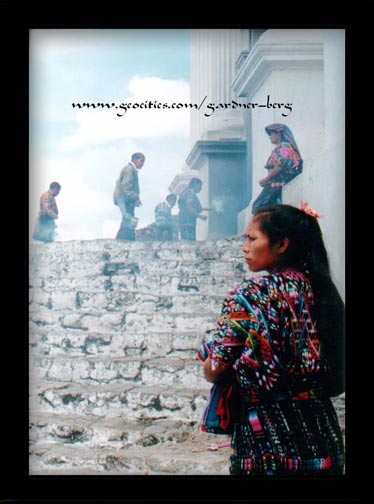
Iglesia de Santo Tomas, Chichicastenango, GUATEMALA
| Translate: Espa˝ol - Franšais - Deutsch - Italiano - Portuguŕs - Japanese - Korean - Chinese |

Iglesia de Santo Tomas, Chichicastenango, GUATEMALA
| Translate: Espa˝ol - Franšais - Deutsch - Italiano - Portuguŕs - Japanese - Korean - Chinese |

 August 3, 1999 -- (0700) We walk, bleary-eyed, from the bus station with our gear to catch another bus heading to Antigua where we will base ourselves once again. Antigua is certainly the place of choice by most foreigners - most evident when we arrived there - most are here to study Spanish.
August 3, 1999 -- (0700) We walk, bleary-eyed, from the bus station with our gear to catch another bus heading to Antigua where we will base ourselves once again. Antigua is certainly the place of choice by most foreigners - most evident when we arrived there - most are here to study Spanish.
August 17, 1999 -- We catch a bus from Antigua and head
south to Escuintla - a route that carves its way
around the base of the mountains descending towards
sea level where temperatures rise dramatically. From
Escuintla, we change buses and turn west to the town
of Santa Lucia Cotzumalguapa. A volcano decides to
vent its presence in the form of thick white clouds on
our way there. It┤s a regular occurence in this area
of the country. This volcano is one of many forming a
very long chain running along the Pacific rim between
Mexico and Panama - some of which our attention will
be focused on, along with their intermont basins during
our travels through Central America.
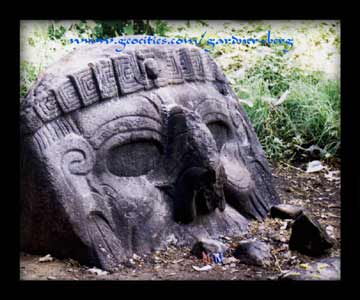
August 18, 1999 -- 0900 and 35░C/90░F - we hike to the edge
of a massive sugarcane field in search of 3 large ninth-century stones which shows artwork of Teotihuacan and Veracruz influences. There were many tracks all scattering in various directions. Local residents gave us some idea on where to find them - without which would definitely have been 3 needles in
a haystack and 10 gallons of water! We found 2 of them -- the third was missing leaving a large deep hole. The first was the best one but there was
evidence of attempted looting. We could see a series
of drilled holes along the middle of the carving in
the hope of breaking it in half. The second stone was
covered with graffiti -- very sad. A few more kms of
uphill walking heading North took us to the ruin site
of El Baul. A polite muchacho showed us a short cut
through the thick cane to the top of a small hill
which is, in fact, an ancient pyramid. (yes thats
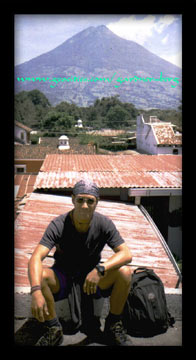 right - another one) built by the Pipiles tribe. We
arrived at the end of a ceremony. Wisps of smoke
rising from mounds of black ash, the smell of candle
wax and the burnt spices fill the air. Two men and a
woman were present. It was very quiet. One of the
men was seated staring at a stone idol - a large half-
buried head elaborately carved. He seemed totally
oblivious to our presence. Both of us felt like
trespassers but the other guy assured us in Spanish
that it was okay - he even let us take photographs.
We didn┤t take many - the camera made a lot of noise.
We shook hands and quietly departed.
right - another one) built by the Pipiles tribe. We
arrived at the end of a ceremony. Wisps of smoke
rising from mounds of black ash, the smell of candle
wax and the burnt spices fill the air. Two men and a
woman were present. It was very quiet. One of the
men was seated staring at a stone idol - a large half-
buried head elaborately carved. He seemed totally
oblivious to our presence. Both of us felt like
trespassers but the other guy assured us in Spanish
that it was okay - he even let us take photographs.
We didn┤t take many - the camera made a lot of noise.
We shook hands and quietly departed.
August 19, 1999 -- We take a day trip to La Democracia to
view carved stone heads displayed in the town┤s
central plaza. The people of this small town are
openly proud of these ancient relics - very friendly.
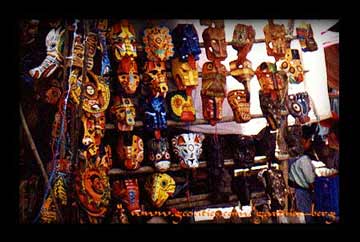
August 21, 1999 -- A 2 hour bus ride west on the Pan Pacific Highway to Retalhuleu; change buses there then slow-paced it up into the highlands north to Quetzaltenango; changed buses again and headed east back to Antigua, thus completing a wide circle around Lake Atitlan - a very scenic route.
August 27, 1999 -- From Guatemala City, we headed northeast to
Quirigua. This ancient site holds the highest stelae
in the known Mayan world - the highest being 39 feet
and built in 771 AD. Excellent detail of the
sculptures preserved. This time, getting to the site
from the village nearby involved walking 4 kms through
a banana plantation. (We passed the Del Monte
processing plant of the way.) We reached an unpaved
road half way there where a Guatemalan was kind enough
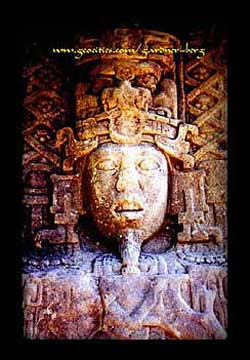 to drive us in his Kenworth truck and trailer the rest
of the way to the ruin site. It was a very hot and
humid day, over 100░F, there was no breeze or any
place to buy water along the way. When walking that
kind of distance under that kind of weather,
availability of water is a very serious issue. But if
you get hungry there are plenty of bananas around.
to drive us in his Kenworth truck and trailer the rest
of the way to the ruin site. It was a very hot and
humid day, over 100░F, there was no breeze or any
place to buy water along the way. When walking that
kind of distance under that kind of weather,
availability of water is a very serious issue. But if
you get hungry there are plenty of bananas around.
August 28, 1999 -- 0700, 5 hours and 3 buses back to Antigua.
August 31, 1999 -- A 2 1/2 hour bus ride from Antigua to the
lakeside town of Panajachel. The lake - Lago de
Atitlan - is probably the most beautiful lake in the
world. This lake is, in fact, the large crater of
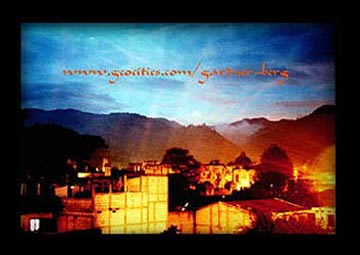 what was once an extremely active volcano. It was so
active that, according to geologists, an eruption
approximately 85,000 years ago wiped out all forms of
life from Mexico to Costa Rica. Now, the lake (1562 m
above sea level) is the most visited place in
Guatemala. It changes colors regularly due to its
mineral salt content and with its 3 volcanos on its
southern rim, green hills, and purple colored
mountains, all of which completely surround it, you
would understand how awe-struck we were during our
500m descent on the road towards Panajachel. We
stayed at a place owned by a wonderful lady,
and like most local women of Mayan descent, she wears
the traditional dress of her tribal group - in her
case, the Cakchiquel people. Very bubbly personality
-- hugs and kisses throughout -- we felt very much at
home.
what was once an extremely active volcano. It was so
active that, according to geologists, an eruption
approximately 85,000 years ago wiped out all forms of
life from Mexico to Costa Rica. Now, the lake (1562 m
above sea level) is the most visited place in
Guatemala. It changes colors regularly due to its
mineral salt content and with its 3 volcanos on its
southern rim, green hills, and purple colored
mountains, all of which completely surround it, you
would understand how awe-struck we were during our
500m descent on the road towards Panajachel. We
stayed at a place owned by a wonderful lady,
and like most local women of Mayan descent, she wears
the traditional dress of her tribal group - in her
case, the Cakchiquel people. Very bubbly personality
-- hugs and kisses throughout -- we felt very much at
home.
September 5, 1999 -- We head north for a day to
Chichicastenango - a place known for its outdoor
market. Very popular with tourists. We walked southwest from
the centre of town to a hilltop ceremonial site called
"Pascual Abaj" where offerings of candles and flower
petals -- very interesting.
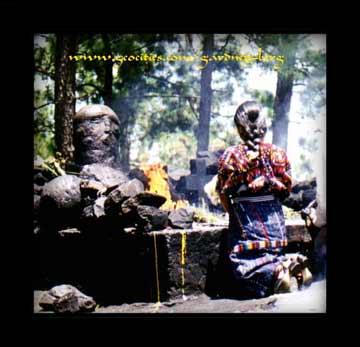
September 6, 1999 -- The next morning we headed early 0630 from Panjachel to Santa Cruz del Quiche (2 1/2 hours north) to visit the ruin site of K┤umarkaaj, a 4km walk west of town. The site
is mostly unexcavated but what was more interesting about
this place were the subterranean burial chambers.
When we entered, there was a chicken sacrifice taking
place deep within- the smell of candle wax everywhere
and you could hear chanting echoing through the
tunnels. Both of us stumbling with our small flashlight
making our way through the smoke-filled tunnel. We
stopped at what looked like an intersection- on our
right was a deep hole with rose petals around the
opening; on out left was another tunnel that led to a
chamber filled with burning candles and ahead of us
was a group of people kneeling in another chamber lit
by candles and a shaman walking around them chanting
while performing the sacrifice of the 'lucky' chicken. We
walked back to town with a sense of amazement. On our way back,
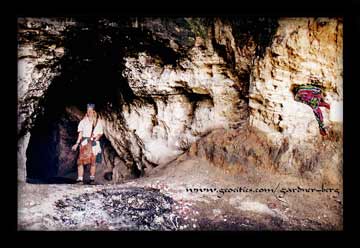 an old man returning from working in the cornfields chats to us about his Mayan
heritage. It was a shame because we
could only understand small parts of what he said.
But he did stress how upset he was regarding a Mayan
idol made of gold that was taken to Spain and how it
should be returned to the Quiche Maya.
an old man returning from working in the cornfields chats to us about his Mayan
heritage. It was a shame because we
could only understand small parts of what he said.
But he did stress how upset he was regarding a Mayan
idol made of gold that was taken to Spain and how it
should be returned to the Quiche Maya.
September 7, 1999 -- We head to the top of the hill from Panajachel to Solola market day - much more traditional. Villagers from all around the lake head to Solola to sell their wares. It┤s one of the few places where traditional dress is worn by both men and women. It was a very colorful spectacle.
September 8, 1999 -- A boat trip across the lake to the
southern end, to Santiago and then to San Pedro. We
had good close-ups of the rugged contours of Volcan San
Pedro.
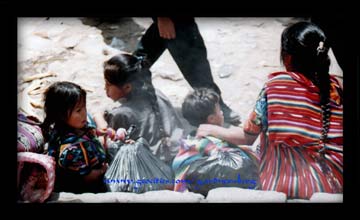
September 12, 1999 -- An early start 0600 from Antigua to Chiquimula and stopping for a night before heading east to the Honduran border the next morning and onward to the ancient city ruins of Copan. We walked across the border to find no buses anywhere. The only transport available are Toyota pickups. Apparently, the road between the border and Copan are in poor condition. So, we hopped on with our gear along with 12 other people, standing on sacks of corn and rice and slowly made our way along a muddy road that hugs the sides of mountains with no barriers to stop us in case we slide sideways to a sheer drop. We did, however, get stuck once. We are in the middle of the rainy season so we expected this kind of road condition here, but the road itself was seriously damaged from the earth beneath it slipping away down the slopes. We passed a few yellow Caterpillar machinery and surrounding workers making repairs.
Photos and Text Copyright ę 1999-2001 Gardner-Berg. All rights reserved.
Sources of Further Reading-
Baudez, Claude and Picasso, Sydney. "The Lost Cities of the Maya" Henry N Adams, Inc., New York, NY. 1992.
Coe, Michael, D. "Lords of the Underworld: Masterpieces of Classic Mayan Ceramics", Priceton University Press, NJ.
Fash, William L. "Scribes, Warriors and Kings: The City of Copan and the Ancient Maya" Thames and Hudson, Ltd, London, 1991.
Menchu, Rigoberta. "I, Rigoberta Menchu: An Indian Woman in Guatemala"
Schele, Linda and Freidel, David A. "A Forest of Kings: The Untold Story of the Maya" Morrow New York, NY.
Sexton, Jame D. "Mayan Folktales: Folklore from Lake Atitlan, Guatemala."
Stephens, John L and Catherwood, Frederick. "Incidents of Travel in Central America, Chiapas and the Yucatan"
Stuart, George C and Stuart, Gene S. "The Mysterious Maya" National Geographic Society, Washington DC., 1997.
Wright, Ronald. "Time Among the Maya".

